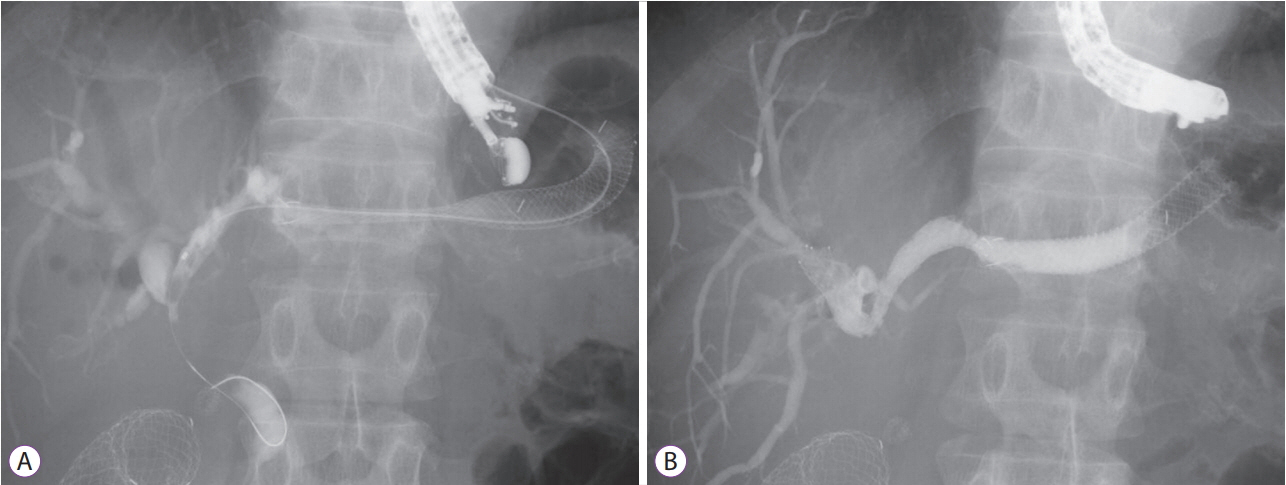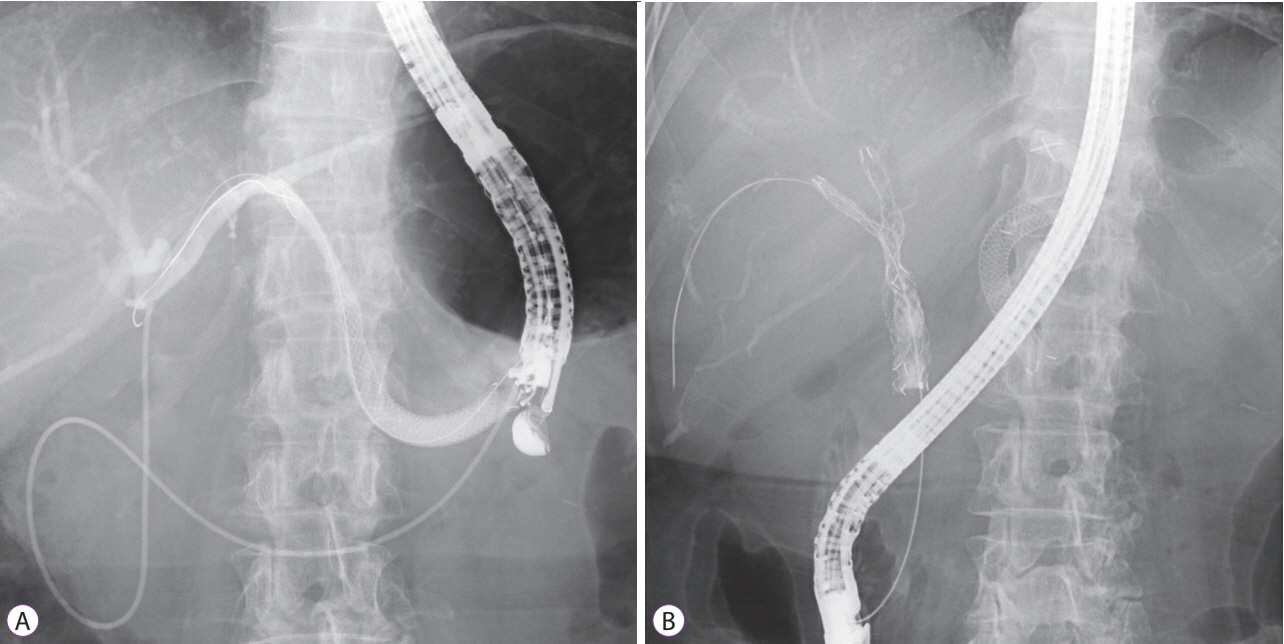Clin Endosc.
2019 May;52(3):220-225. 10.5946/ce.2018.094.
Endoscopic Ultrasound-Guided Biliary Drainage for Unresectable Hilar Malignant Biliary Obstruction
- Affiliations
-
- 1Department of Gastroenterology, Graduate School of Medicine, The University of Tokyo, Japan. ynakai-tky@umin.ac.jp
- 2Department of Gastroenterology, Graduate School of Medicine, Juntendo University, Tokyo, Japan.
- KMID: 2449760
- DOI: http://doi.org/10.5946/ce.2018.094
Abstract
- Endoscopic transpapillary biliary drainage is the current standard of care for unresectable hilar malignant biliary obstruction (MBO) and bilateral metal stent placement is shown to have longer patency. However, technical and clinical failure is possible and percutaneous transhepatic biliary drainage (PTBD) is sometimes necessary. Endoscopic ultrasound-guided biliary drainage (EUS-BD) is increasingly being reported as an alternative rescue procedure to PTBD. EUS-BD has a potential advantage of not traversing the biliary stricture and internal drainage can be completed in a single session. Some approaches to bilateral biliary drainage for hilar MBO under EUS-guidance include a bridging method, hepaticoduodenostomy, and a combination of EUS-BD and transpapillary biliary drainage. The aim of this review is to summarize data on EUS-BD for hilar MBO and to clarify its advantages over the conventional approaches such as endoscopic transpapillary biliary drainage and PTBD.
Figure
Cited by 3 articles
-
A Recent Update on Endoscopic Drainage of Advanced Malignant Hilar Obstruction
Tae Hoon Lee, Jong Ho Moon, Sang-Heum Park
Korean J Gastroenterol. 2021;78(2):94-104. doi: 10.4166/kjg.2021.111.What You Need to Know Before Performing Endoscopic Ultrasound-guided Hepaticogastrostomy
Tanyaporn Chantarojanasiri, Thawee Ratanachu-Ek, Nonthalee Pausawasdi
Clin Endosc. 2021;54(3):301-308. doi: 10.5946/ce.2021.103.Endoscopic Biliary Drainage for Hilar Obstruction: Further Evidence But Still A Long Way To Go
Yousuke Nakai
Clin Endosc. 2021;54(5):629-630. doi: 10.5946/ce.2021.158.
Reference
-
1. Moon JH, Rerknimitr R, Kogure H, Nakai Y, Isayama H. Topic controversies in the endoscopic management of malignant hilar strictures using metal stent: side-by-side versus stent-in-stent techniques. J Hepatobiliary Pancreat Sci. 2015; 22:650–656.
Article2. Nakai Y, Isayama H, Yamamoto N, et al. Indications for endoscopic ultrasonography (EUS)-guided biliary intervention: does EUS always come after failed endoscopic retrograde cholangiopancreatography? Dig Endosc. 2017; 29:218–225.3. Minaga K, Kitano M. Recent advances in endoscopic ultrasound-guided biliary drainage. Dig Endosc. 2018; 30:38–47.
Article4. Nakai Y, Isayama H, Matsubara S, Koike K. Conversion of transpapillary drainage to endoscopic ultrasound-guided hepaticogastrostomy and gallbladder drainage in a case of malignant biliary obstruction with recurrent cholangitis and cholecystitis (with videos). Endosc Ultrasound. 2017; 6:205–207.
Article5. Moole H, Dharmapuri S, Duvvuri A, et al. Endoscopic versus percutaneous biliary drainage in palliation of advanced malignant hilar obstruction: a meta-analysis and systematic review. Can J Gastroenterol Hepatol. 2016; 2016:4726078.
Article6. Sangchan A, Kongkasame W, Pugkhem A, Jenwitheesuk K, Mairiang P. Efficacy of metal and plastic stents in unresectable complex hilar cholangiocarcinoma: a randomized controlled trial. Gastrointest Endosc. 2012; 76:93–99.
Article7. Mukai T, Yasuda I, Nakashima M, et al. Metallic stents are more efficacious than plastic stents in unresectable malignant hilar biliary strictures: a randomized controlled trial. J Hepatobiliary Pancreat Sci. 2013; 20:214–222.
Article8. De Palma GD, Galloro G, Siciliano S, Iovino P, Catanzano C. Unilateral versus bilateral endoscopic hepatic duct drainage in patients with malignant hilar biliary obstruction: results of a prospective, randomized, and controlled study. Gastrointest Endosc. 2001; 53:547–553.
Article9. Yasuda I, Mukai T, Moriwaki H. Unilateral versus bilateral endoscopic biliary stenting for malignant hilar biliary strictures. Dig Endosc. 2013; 25 Suppl 2:81–85.
Article10. Takahashi E, Fukasawa M, Sato T, et al. Biliary drainage strategy of unresectable malignant hilar strictures by computed tomography volumetry. World J Gastroenterol. 2015; 21:4946–4953.
Article11. Vienne A, Hobeika E, Gouya H, et al. Prediction of drainage effectiveness during endoscopic stenting of malignant hilar strictures: the role of liver volume assessment. Gastrointest Endosc. 2010; 72:728–735.
Article12. Lee TH, Kim TH, Moon JH, et al. Bilateral versus unilateral placement of metal stents for inoperable high-grade malignant hilar biliary strictures: a multicenter, prospective, randomized study (with video). Gastrointest Endosc. 2017; 86:817–827.13. Lee TH, Moon JH, Kim JH, et al. Primary and revision efficacy of crosswired metallic stents for endoscopic bilateral stent-in-stent placement in malignant hilar biliary strictures. Endoscopy. 2013; 45:106–113.
Article14. Kogure H, Isayama H, Nakai Y, et al. High single-session success rate of endoscopic bilateral stent-in-stent placement with modified large cell Niti-S stents for malignant hilar biliary obstruction. Dig Endosc. 2014; 26:93–99.15. Lee TH, Park DH, Lee SS, et al. Technical feasibility and revision efficacy of the sequential deployment of endoscopic bilateral side-by-side metal stents for malignant hilar biliary strictures: a multicenter prospective study. Dig Dis Sci. 2013; 58:547–555.
Article16. Lee TH, Moon JH, Choi HJ, et al. Third metal stent for revision of malignant hilar biliary strictures. Endoscopy. 2016; 48:1129–1133.
Article17. Nakai Y, Isayama H, Yamamoto N, et al. Safety and effectiveness of a long, partially covered metal stent for endoscopic ultrasound-guided hepaticogastrostomy in patients with malignant biliary obstruction. Endoscopy. 2016; 48:1125–1128.
Article18. Ogura T, Sano T, Onda S, et al. Endoscopic ultrasound-guided biliary drainage for right hepatic bile duct obstruction: novel technical tips. Endoscopy. 2015; 47:72–75.
Article19. Park SJ, Choi JH, Park DH, et al. Expanding indication: EUS-guided hepaticoduodenostomy for isolated right intrahepatic duct obstruction (with video). Gastrointest Endosc. 2013; 78:374–380.
Article20. Mukai S, Itoi T, Tsuchiya T, Tanaka R, Tonozuka R. EUS-guided right hepatic bile duct drainage in complicated hilar stricture. Gastrointest Endosc. 2017; 85:256–257.
Article21. Park DH. Endoscopic ultrasound-guided biliary drainage of hilar biliary obstruction. J Hepatobiliary Pancreat Sci. 2015; 22:664–668.
Article22. Bories E, Pesenti C, Caillol F, Lopes C, Giovannini M. Transgastric endoscopic ultrasonography-guided biliary drainage: results of a pilot study. Endoscopy. 2007; 39:287–291.23. Ogura T, Masuda D, Imoto A, Umegaki E, Higuchi K. EUS-guided hepaticogastrostomy for hepatic hilar obstruction. Endoscopy. 2014; 46 Suppl 1 UCTN:E32–E33.
Article24. Prachayakul V, Aswakul P. Endoscopic ultrasound-guided biliary drainage: bilateral systems drainage via left duct approach. World J Gastroenterol. 2015; 21:10045–10048.25. Moryoussef F, Sportes A, Leblanc S, Bachet JB, Chaussade S, Prat F. Is EUS-guided drainage a suitable alternative technique in case of proximal biliary obstruction? Therap Adv Gastroenterol. 2017; 10:537–544.
Article26. Park DH, Song TJ, Eum J, et al. EUS-guided hepaticogastrostomy with a fully covered metal stent as the biliary diversion technique for an occluded biliary metal stent after a failed ERCP (with videos). Gastrointest Endosc. 2010; 71:413–419.
Article27. Minaga K, Takenaka M, Kitano M, et al. Rescue EUS-guided intrahepatic biliary drainage for malignant hilar biliary stricture after failed transpapillary re-intervention. Surg Endosc. 2017; 31:4764–4772.
Article28. Ogura T, Onda S, Takagi W, et al. Clinical utility of endoscopic ultrasound-guided biliary drainage as a rescue of re-intervention procedure for high-grade hilar stricture. J Gastroenterol Hepatol. 2017; 32:163–168.
Article29. Kanno Y, Ito K, Koshita S, et al. EUS-guided biliary drainage for malignant perihilar biliary strictures after further transpapillary intervention has been judged to be impossible or ineffective. Intern Med. 2017; 56:3145–3151.
Article30. Wang K, Zhu J, Xing L, Wang Y, Jin Z, Li Z. Assessment of efficacy and safety of EUS-guided biliary drainage: a systematic review. Gastrointest Endosc. 2016; 83:1218–1227.31. Dhir V, Artifon EL, Gupta K, et al. Multicenter study on endoscopic ultrasound-guided expandable biliary metal stent placement: choice of access route, direction of stent insertion, and drainage route. Dig Endosc. 2014; 26:430–435.
Article32. Paik WH, Lee NK, Nakai Y, et al. Conversion of external percutaneous transhepatic biliary drainage to endoscopic ultrasound-guided hepaticogastrostomy after failed standard internal stenting for malignant biliary obstruction. Endoscopy. 2017; 49:544–548.
Article
- Full Text Links
- Actions
-
Cited
- CITED
-
- Close
- Share
- Similar articles
-
- Endoscopic Stent Placement in the Palliation of Malignant Biliary Obstruction
- Endoscopic ultrasound-guided biliary drainage in malignant hilar obstruction
- Technical Tips and Issues of Biliary Stenting, Focusing on Malignant Hilar Obstruction
- Endoscopic ultrasound-guided biliary drainage in malignant distal biliary obstruction
- Endoscopic ultrasound-guided intervention for inaccessible papilla in advanced malignant hilar biliary obstruction




